|
more 1920s topics Nostalgia Cafe main page Nostalgia Cafe site map | At Home, 1920s Style============================================================ ============================================================ ============================================================ | ||
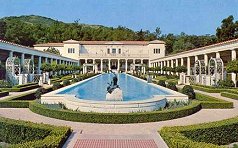  For the upper classes, exotic home decor became very fashionable. After Howard Carter discovered King Tut's tomb in 1922, Egyptian decor became all the rage. 
| ----- |  upper class  Wealthy homeowners followed new trends in the 1920s. The sunny California lifestyle was gaining popularity, and the motion picture industry was creating a new class of celebrities. Rich people left their Manhattan mansions and flocked to the new sun-drenched playgrounds of Florida and California. Mediterranean, Spanish and art deco architecture became popular styles for upper class homes. | ||
middle class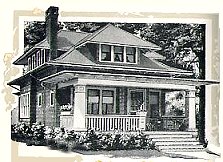 the bungalow 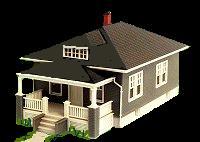 The bungalow was the most popular suburban home style during this decade. Many cities were surrounded by a "bungalow belt"....a ring of suburbs built during the 1920s in which the bungalow was the dominant home style. The bungalow was the most popular suburban home style during this decade. Many cities were surrounded by a "bungalow belt"....a ring of suburbs built during the 1920s in which the bungalow was the dominant home style.The earliest bungalows were built in the 1880s. These simple one-story homes began to increase in popularity around 1900, especially in California, where they became known as California houses. By the 1920s, bungalows were common all across the country. A bungalow was the perfect home for the times: affordable, easy to maintain and clean, and easily adapted to the new automobile lifestyle. Sears Homes Sears Modern Homes |
Sears homes Between 1908 and 1940, thousands of people purchased their homes from the Sears catalog. A Sears home arrived by train in several large crates, and the buyer was responsible for construction. Everything you needed was inside the crates: lumber, fixtures, nails, paint and instructions.  tudor Tudor style homes were also popular in the 1920s. These houses were usually found in upper-middle class suburbs, and featured distinctive English half-timber exteriors.  the garage During the 1900s and 1910s, most homes did not have a garage. Because a homeowner didn't add a garage until he purchased his first motor car, the typical garage was usually just a converted barn or detached building added after the house was built. In the 1920s, garages were becoming more common, and new homes were being built with garages already present. Less-expensive homes continued to feature detached garages, while the new suburban tudor and colonial revival homes began to include the occasional attached garage. | |||
 electricity electricitybefore the 1920s Between the 1880s and the 1910s, electricity was installed in public buildings and upper class homes. Because it was expensive, somewhat unreliable and almost completely absent from rural areas, only 35 percent of all homes were wired for electricity in 1920. electricity for the average home The power distribution system gradually became more efficient, and by 1927 the price of electricity was 55 percent lower than it was in 1907. Electricity was now affordable for middle class and working class families. By the end of the 1920s, the number of homes with electricity had increased to 68 percent. Of course, this figure represents all American homes, regardless of class or location. There was actually a large gap between upper and lower class homes. different levels of service  Many homes had only enough wiring to power their electric lights. A minimal system of this type could support other small appliances, such as fans, toasters, irons, sewing machines and radios. In the early 1920s, these items were usually screwed directly into the light sockets, or were plugged into the sockets using a two-prong plug and special adaptor. In the late 1920s, convenience wall outlets started to become more common, although in the mid 1920s, the average American home had only three convenience outlets. Many homes had only enough wiring to power their electric lights. A minimal system of this type could support other small appliances, such as fans, toasters, irons, sewing machines and radios. In the early 1920s, these items were usually screwed directly into the light sockets, or were plugged into the sockets using a two-prong plug and special adaptor. In the late 1920s, convenience wall outlets started to become more common, although in the mid 1920s, the average American home had only three convenience outlets.
|
upgrading to higher power levels During the 1920s, many families were purchasing larger appliances, such as vacuum cleaners, refrigerators and washing machines. They began to install heavy-duty electrical systems that could support higher power levels and a wide range of appliances. 
upper class homes Most upper class homes were fully wired for electricity. They were more likely to have larger appliances that required a complete system. middle class & working class homes Middle class homes fared better than the national average....73 percent had electricity by 1927. rural & lower class homes In the 1920s, very little progress was made in bringing electricity to rural areas. Overall, only 10 percent of farm homes had electricity, although in some states this amount was as low as 1 percent. | |||
| homes without electricity By the end of the decade, 32 percent of urban homes and 90 percent of farm homes were still without electricity. In town, these families relied on gas fixtures for light. On the farm, kerosene lamps were a neccessity. This was a world of battery-powered radios, foot-treadle sewing machines, manually-operated washing machines, iceboxes and irons heated over the stove. | ||||
|
home heating In the 1920s, homes had either central heating or local heating. Central heating consisted of furnaces and radiators, and local heating used fireplaces, parlor stoves and kitchen stoves. Central heating systems were powered by whatever fuel was available. In most areas, this was coal. Gas and fuel oil were used to a lesser extent, but were gaining in popularity. Gas was used in the cities and towns where it was available, and many homes without city gas service were converting to fuel oil. furnace The furnace used gravity to send hot air into each room through air ducts. Because a coal furnace needed to be fired hourly, the house was usually cold in the morning. Banking the furnace involved arranging the coal so that it would burn all night without firing.
| 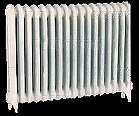 radiator In a wet heat system, a boiler creates hot water or steam, which is circulated throughout the house and conveyed to each room by a cast-iron radiator. This heating method was first used regularly in the 1880s, and was actually more common than furnaces until the 1920s. After this, furnaces became more efficient, and radiators were generally restricted to large city buildings and older homes. stoves A majority of homes in the 1920s did not have central heating, especially those in the country. The cookstove warmed the kitchen, and a cast-iron parlor stove kept the sitting area warm. The bedrooms were often unheated, which made for some very rude awakenings on frosty winter mornings! Grills in the ceiling carried a small amount of stove heat up to the second floor, but this system did not work very well. | |||
apartments | 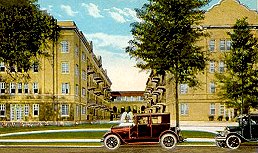 Orange Court Apartment Hotel, Orlando, Florida | |||
| in the parlor corner wall shelves for bric-a-brac fringed lampshades crocheted doilies overstuffed chairs  For the family sing-along, many parlors had an ornate upright piano or parlor spinet. There was room in the bench for lots of sheet music. If you didn't play, you could purchase a pianola player piano and have the perforated piano rolls do the playing for you! 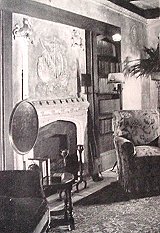 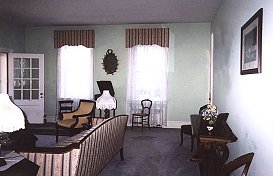 | |||
 in the bathroom in the bathroomIn the 1920s, there were two types of bathroom arrangements: 1) individual fixtures being installed in older homes, and 2) complete, fully-connected modern bathrooms. the toilet In 1920, only 20 percent of American homes had a flush toilet. This figure increased to 50 percent by 1930. Again, this number represents all homes, regardless of class or location. As usual, working class and rural homes fell below the national average. By 1929, only 30 percent of working class homes and 20 percent of rural homes had a flush toilet. The number of homes with connected bathtubs depended on the presence of indoor plumbing. Here, the gap was quite large....90 percent of urban and upper class homes had indoor plumbing, while only 15 percent of rural homes did. older homes In older homes, there were limits to where flush toilets, water pipes and fully-connected bathtubs could be installed. It wasn't always possible to put everything in the same room. Your toilet may have been located in the basement or a converted closet, and the tub may have been installed in the kitchen or lean-to. 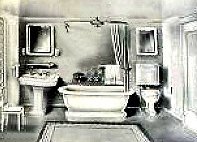 the modern bathroom Modern bathrooms featured a bathtub, sink and flush toilet located in a room designed especially for their use. Complete bathrooms had been common in hotels and upper class homes since the turn of the century. By 1927, 60 percent of middle class homes had an indoor bathroom with a toilet and tub. Things were different in the country, however, where only 5 percent of homes had a complete indoor bathroom with a toilet and tub. Indoor conveniences weren't a priority for everyone, it seems. In 1929, quite a few families chose to spend their money on a car before getting indoor plumbing. | 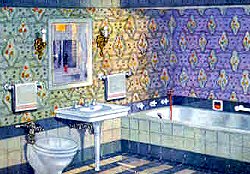  new features new featuresIn modern homes, owners took things to the next level by installing self-fired water heaters and water softeners. They replaced claw-foot bathtubs with built-in tubs, and some homeowners installed showers. Before the late 1920s, showers were reserved for hospitals, barracks and gymnasiums. An obsession with hygiene and sanitation during this decade made them popular for the average home. In most bathrooms, the fixtures were white. Gleaming chrome and white porcelain looked clean and sanitary, which made them the top decorating choices.  | |||
| homes without modern bathrooms In the 1920s, having a complete indoor bathroom was a rarity for many families, especially for those who lived in the country. You probably had a claw-foot or tin bathtub, but no indoor plumbing. The water for your Saturday night bath was hauled in from a well, hand pump or cistern, and was heated on the kitchen stove. Between 50 and 80 percent of us still had to use the old "two-holer" out back! In polite company, an outhouse was also known as a privy. |   | |||
 1920s icebox 1920s iceboxthe icebox & the refrigerator The icebox had three parts: the shelves where food was kept cool, the compartment for the block of ice, and the drip pan underneath. Under normal conditions, a one-foot-square block of ice lasted a week. The drip pan caught the water as the ice melted. The first mechanical refrigerators for the home were introduced in 1911. By the early 1920s, there were 56 companies producing and selling 200 different models. In 1923, there were 20,000 refrigerators in America, and the average cost of a unit was $450. At first, refrigerators resembled iceboxes, with motors and compressors that were external and separate from the unit. Usually, these parts were located in the basement or an adjoining room. In the 1920s, refrigerators became self-contained machines made of steel and porcelain, and the motor was part of the unit. The monitor top models of the late 1920s had a motor enclosed in a cylindrical cabinet on top. |
| |||
|
"Putting up" beans, tomatoes, preserves, jellies, pickles and beets was a common activity for farm wives, immigrants and the average homemaker. The practice was losing favor with some women, however. City housewives didn't have gardens, poor women who worked outside the home didn't have the time, and wealthy homemakers couldn't be bothered. Besides, store-bought canned foods were just too easy and convenient to ignore!
|  The range or cookstove was powered by whatever fuel was available. For most homes, this was coal. In towns and cities where it was available, gas was the number one fuel, although electricity was gaining in popularity. Country wives cooked on wood-burning stoves. 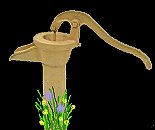 10 percent of urban homes and 85 percent of farm homes relied on wells and hand pumps for water. Usually, the pump was in the backyard, just outside the kitchen door. If you were lucky, you had a hand pump installed inside your kitchen. | |||
return to the 1920s main page